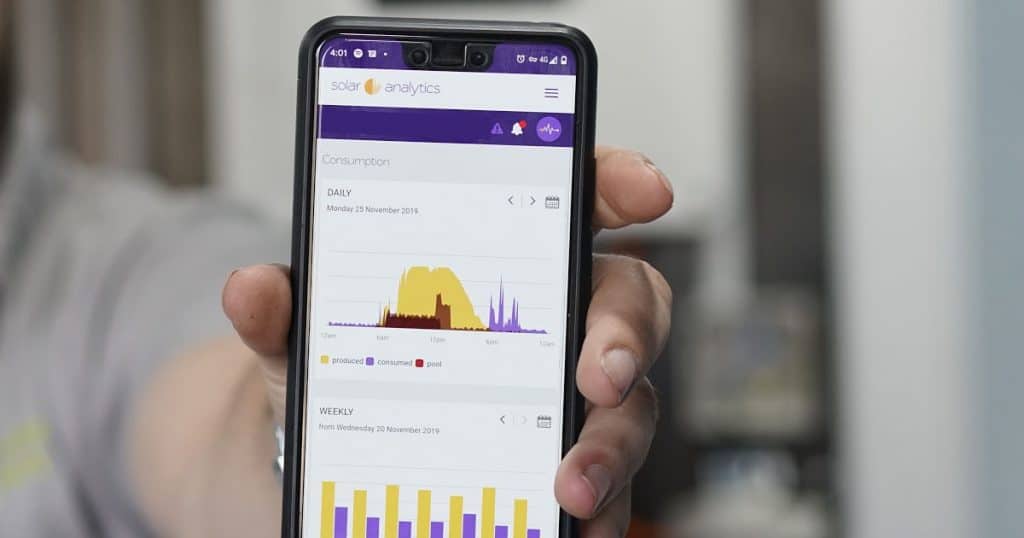In business management, you’ll likely hear the phrase “what gets measured, get managed” or some variation thereof. It essentially means that if you’re looking to improve or maintain something, the best place to start is by measuring it.
The same can be said when it comes to monitoring systems for solar power. If you want to keep your system in top form, then measuring its performance can help you turn data into actionable information.
At their core, solar monitoring systems have been developed to help homeowners and businesses maximise their system’s performance and, ultimately, save money. This article will provide an overview of solar power monitoring systems, their key features, and the benefits they offer. It will also look at advanced monitoring options, including circuit and panel level monitoring.

How do solar power monitoring systems work?
A solar monitoring system works through the solar system’s inverter. In most cases, companies sell their inverters with a patented, built-in monitoring software setup. You can, however, invest in third-party solar monitoring systems that provide a more in-depth analysis of your system’s health and performance.
Depending on the system, solar monitoring can give you historical and real-time data on everything from how much electricity your panels are producing and how much you’re using from the grid, to the temperature of your panels, and how much impact shade has on their output. It can also alert you to problems with your system that you’d otherwise miss until you receive an unexpectedly high power bill.
What do solar power monitoring systems track?
Not all solar power monitoring systems offer the same features. You’ll often find that the in-built monitoring that comes with your inverter offers far fewer features than third-party monitoring systems – sometimes just basic production monitoring.
Depending on your elected monitoring system, you may be able to track the following:
- Solar energy production
- Solar energy consumption
- Grid exports and imports
- Advanced system monitoring (circuit level, panel level, cost tracking, etc.)
In general, you can access this information via an internet portal or smart phone application. The data should be updated every few seconds.
Note: older inverters probably won’t be able to connect to Wi-Fi, but you might still be able to access some production monitoring on the inverter’s LED screen or on a computer via a ethernet port.
Solar energy production monitoring
The solar energy production monitoring feature of a system will show you how much electricity your solar panels in Australia are producing in kWh. It also records the total amount of power they have produced over time so that you can see their historical performance and compare it with previous readings to determine if there is any variation from one period of time to another. All inverters will have a built-in production monitoring function.
Solar energy consumption monitoring
Consumption monitoring allows you to see what happens to solar energy after you produce it. You will be able to track your consumption over the course of the day and adjust your consumption habits to better utlise your solar-generated energy and save money.
While some inverters include (very) basic consumption monitoring, many don’t. There are a variety of ways to access more detailed consumption data, the most common involving the additional purchase of a “smart meter” or an advanced monitoring system that integrates with your inverter.
In most cases, consumption monitoring via a smart meter like Fronius will cost an additional $300-$500, while advanced monitoring systems that offer more features (discussed below) can cost upwards of $800.
Grid export/import monitoring
This feature is useful because it shows how much electricity your solar panels are exporting to the grid, and how much they’re importing from it. It will also show you any credit that your system is earning or using at a given time. This feature can be particularly useful if you have net metering set up with your electric company because it lets you see where all of the power produced by your solar panels is going during each billing period.

Advanced system monitoring
Advanced third-party monitoring systems and applications such as Solar Analytics and Fronius use smart algorithms to interpret and deliver consumption and performance data in a practical, actionable way.
While there are multiple choices when considering which monitoring system to install, they can be divided into two principal types: System Level Monitoring (SLM) and Panel Level monitoring (PLM).
These monitoring systems will help you get more value from your solar system and a more complete view of your home’s energy profile. Below are some of the advanced features and systems available.
Circuit level monitoring: Circuit level monitoring allows you to see how much power individual appliances draw from your system. This can help you identify any unexpected draws on the electricity produced by your panels and determine whether they’re legitimate or a sign of an issue with your system.
Panel Level Monitoring (PLM): Also known as module-level monitoring, PLM is directly related to module-level power electronics (MLPE) solutions of the solar industry including microinverters and power optimisers.
PLM shows values and data for each individual panel in the array. This is a huge advantage because it shows how much electricity each panel is producing, allowing you or your solar installer to rapidly detect if there are any issues with individual components on a panel and which direction they’re facing so that you can determine if an issue stems from shading or something else entirely.
Performance and fault alerts: Unlike the data that comes from most inverters, third-party monitoring systems can detect when your solar system’s output is poor or nil, and alert you with a timely email or SMS.
Good quality third-party monitoring will know the correct performance to be expected from your panels and inverter. Using local weather data, the system will alert you if performance drops below the minimum guaranteed in your warranty.
Cost tracking: Good monitoring systems allow for complete end-user entry of your electricity rates. This might include the daily supply charge, time-of-use tariffs, weekday vs weekend tariffs, solar feed-in tariff, and more.
The benefits? These monitoring systems use your actual solar and household energy data to provide a factual breakdown of what your power bill should be. They can also compare the available energy plans on the market and automatically find the best plan for you.
What about ‘type 4’ smart meters?
Different to the smart meters mentioned earlier, energy distributor owned smart meters allow households to monitor their usage and adjust their consumption habits accordingly, whether they have solar installed or not. For solar users, it is important to understand exactly what smart meters can and cannot do. Smart meters do the following:
- Measure total energy use in the house and report the data back to the energy distributor.
- For solar households, smart meters can also measure how much energy is flowing in the opposite direction, back into the grid.
- Perform a net metering function which will allow solar power generated at the home to be used at the home before any excess gets sent back into the grid.
Some of your home’s smart meter data can be accessed via a portal on your energy distributor’s website.
On the downside, smart meters cannot tell users specifically how much power the solar system is generating. It can only measure a net position based on total electricity in vs electricity out.
Smart meters also cannot detect faults when the solar system is not working properly or determine how efficiently the system is operating.
What are the benefits of solar monitoring systems?
The benefits of solar monitoring are plentiful, and you could potentially save hundreds of dollars a year. The top three benefits are as follows:
- Maximised solar power production: Find out when your solar panels aren’t producing power as expected and take action before it results in costly downtime.
- Increased solar self-consumption: As solar feed-in tariffs drop, it’s becoming more important to increase your solar self-consumption during the day. A good monitoring system will alert you to the best time to operate energy-intensive appliances like your washing machine so you can use more of your self-generated electricity rather than draw from the grid.
- Understanding fluctuations in your energy bill: if you receive an unexpectedly high energy bill, your first thought might be that your panels aren’t working properly. While that may be the reason, it could also be a number of other factors including consuming more energy, changing tariffs, or a billing error. A monitoring system will quickly pinpoint the reason so you can get your bills back on track.
Is advanced system monitoring worth the investment?
As mentioned earlier, a third-party monitoring system with circuit and/or panel level monitoring will offer in-depth data and actionable information presented in a user-friendly interface, which goes far beyond what you can expect to receive from an inverter’s in-built monitoring system.
A study funded by the Australian Renewable Energy Agency (ARENA) determined that households using third-party software Solar Analytics increased their solar generation by 14 per cent. The increase was achieved by detecting faults that impact solar generation faster, allowing issues to be quickly rectified.
Solar monitoring systems address the argument that solar relies too heavily on the effort of the homeowner to get the most out of their investment. They aim to simplify the process by taking a lot of the guesswork out of maximising production and self-consumption. Rather than putting solar system performance management in the “too hard” basket, you can quickly and easily identify or opportunities for improvement and action them accordingly.
So is it worth the extra money? Yes, we believe it is. If you want to get the most out of your solar system, a monitoring system empowers you to take full advantage of all it has to offer without needing an engineering or maths degree to comprehend the data.
If knowledge is power, then a solar monitoring system is the key to unlocking it.
Energy Matters has assisted over 30,000 Australians in their transition to clean energy. We can guide you toward a solar and/or battery storage solution that fits your lifestyle and budget. Receive up to 3, obligation-free solar quotes from our trusted network of accredited solar installers. It’s fast, free, and takes the hassle out of shopping around.
Our professional solar installers in Melbourne will assess and determine your energy needs. We customise a solar panel system in Melbourne to fit the roof size of your properly, ensuring you receive the most suitable a solar panel system for your Melbourne home, meeting to property’s energy requirements.












































